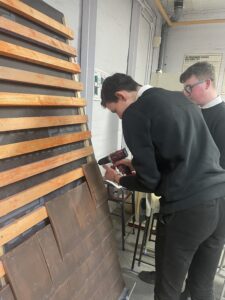James Talman, NFRC chief executive, talks about some of the challenges for the roofing sector and how the Federation is responding.

James Talman, NFRC chief executive, has been leading the Federation as it seeks to raise the profile of its members and the roofing industry within the wider built environment. That includes taking an active role in some of the critical issues of the day, such the response to the Grenfell Tower fire and retentions, as well as pushing forward the skills and competency agenda. Here he talks to the Roofing Times about these and other issues.
Grenfell was a wake-up call. Aside from issues around the cladding and building regs what can our industry do in the short-to-medium term to prevent another incident?
A lack of competency was cited as a major factor in the Grenfell tragedy and reading some of the reports about the poor standards of workmanship makes for very uncomfortable reading. But that’s an area that we as an industry can start improving right now. The NFRC, for example, will be launching a basic entry-level course for the installation of rainscreens in partnership with the CITB and Build UK, which will help to train the additional workforce that will be needed to re-clad existing tower blocks. We’re also seeking to create a supervisor-level training course aimed at project managers, which we see as essential to ensuring contractors are managing quality properly. This all feeds into the NFRC’s work to establish an accreditation programme for the roofing and cladding workforce.
In general, how is the NFRC helping to improve safety?
As a trade federation, we’re constantly reviewing risks and seeing how they directly relate to our trade members—whether it be working near asbestos, the dangers of skin cancer or working near gas flues. Then there is specific safety guidance. For instance, we’ve developed Safe2Torch with industry to improve the specification, design and installation of RBM and other roof coverings, which need to be heated with gas torches. This is an obvious fire risk and I’m proud to say that the Safe2Torch campaign received a positive response from members and non-members, with 284 companies so far pledging their support for the guidance. The NFRC also contributed to a parliamentary review of falls from heights, which is a leading cause of fatalities. We are also shortly launching a consumer piece to the householder on the importance of safety in the quality of the completed job.
Do you see the collapse of Carillion as a milestone in the abolition of retentions?
Carillion has for the first time shone a very public light on this thorny issue. We’ve seen 100 MPs supporting the Construction (Retention Deposit Schemes) Bill put forward by Peter Aldous MP, which would see cash retentions ring-fenced in a third-party trust. We understand the motive for this Bill but it doesn’t get rid of the problem. We therefore support Build UK’s position, which is to seek zero cash retentions but feel the target date of 2023 is lacking urgency. Ultimately it is about changing behaviours. There are pages of newsprint about how the industry needs to change. There are many examples now of contractors agreeing to no retention contracts. Clients who use our members should not be using this outdated weapon. Our members are there to do the job right, to high standards and to stand behind their assurances. If in the unlikely event of a problem we are there to assist. All those who actually build something should make clear on their T&Cs that they support Fair Payment and won’t accept retentions.
“There are many examples now of contractors agreeing to no retention contracts. Clients who use our members should not be using this outdated weapon. Our members are there to do the job right, to high standards and to stand behind their assurances”
Offsite construction—a threat or an opportunity for the roofing?
We see offsite construction as including any element of a building that’s been manufactured in a factory, such as roof elements, SIPS panels and indeed cladding. A lot of industrial type roofing lends itself to this kind manufactured process, therefore, if embraced properly, we shouldn’t see it as a threat, because it helps to reduce defects and enhance productivity. This has got to be a benefit for NFRC members. In fact, the roofing sector can and is assisting the development of offsite; one NFRC member, for example, is working on several projects that require their operatives to assemble in the factory. In certain projects there might also be the opportunity for roofing contractors to adopt offsite assembly of roofing elements themselves to reduce time on site and boost productivity. Ultimately, though, government is increasingly seeing offsite construction as a way to increase housebuilding and has also said it will favour offsite on government-procured contracts, so it’s something we can’t ignore.
BIM and other digital technologies are another source of disruption, but how relevant are they to SMEs?
If we look specifically at BIM—like offsite it is really all about collaboration, which again comes back to improving productivity and quality. Roofing suppliers are already providing data profiles of their products to go into the BIM model but contractors of any size that are working on large BIM-enabled contracts—particularly public-sector contracts—will need to understand BIM Level 2 and may even need to demonstrate that knowledge to the main contractor when tendering for work. As for the other technologies, they are absolutely relevant to all members. Take, for example, the increasing use of drones in aerial surveys, which can not only reduce time but can also improve safety. In fact, earlier this year we produced guidance with Association of Remotely Piloted Aircraft for the safe and legal use of drones among members and the wider sector.
The roofing sector seems to have an image problem. How do we both attract a new generation of roofers and improve trust among customers?
Despite the fantastic work that roofing contractors deliver day in and day out on the largest commercial buildings to the smallest domestic properties, there is still a lingering perception of the unskilled cowboy roofer. This is why we are increasingly getting enquiries from both householders and housing associations looking to source NFRC members, because they see it as a badge of trust. More work clearly needs to be done to improve trust, which we are seeking to do through the development of an accredited roofing scheme with the CITB. Crucially, we believe that this will also help to provide a clearer career progression for roofing contractors, helping to upskill our existing workforce but also helping to attract a new generation of roofers, which is critical as more roofers near retirement.
The NFRC has been increasing its profile—why is this important?
In the past 10 years the NFRC’s profile has risen by being more representative across the whole supply chain, highlighting the partnership between contractors and suppliers, as well as raising its profile within the built environment as a whole. We’ve been building on that over the past couple of years because like all trade bodies, we need to keep up with a rapidly-changing world and constantly provide value to the members. This means being recognised as the independent voice for roofing within the wider construction industry, pushing forward the skills and quality agenda, as well as representing the sector on issues such as retentions. It also means being the trusted source of information in a world where information is more freely available than ever before, but which may not be of the best quality. Increased recognition among customers should, by implication bring benefit to members through new work.
Finally, what do you see is the greatest prize for NFRC and its members in the next three years?
Building the broader reputation within the built environment is the greatest prize because the more influence we have as a sector in meeting the current challenges, the more opportunities there are for the benefit of our members.



